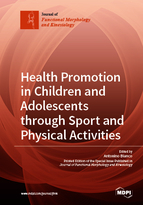Health Promotion in Children and Adolescents through Sport and Physical Activities
A special issue of Journal of Functional Morphology and Kinesiology (ISSN 2411-5142).
Deadline for manuscript submissions: closed (31 December 2018) | Viewed by 64318
Special Issue Editor
Interests: physical activity; training; strength and conditioning; health promotion; COVID-19 pandemic
Special Issues, Collections and Topics in MDPI journals
Special Issue Information
Dear Colleagues,
I made the important decision to handle a Special Issue because I believe it to be extremely crucial to focus on proper children’s and adolescents’ physiological and psychological development. The idea is to collect research that investigate the role of physical activity and sport on physical and mental well-being, with particular focus on practical implications, innovation, tools, and technique development. The Special Issue, “Health Promotion in Children and Adolescents through Sport and Physical Activities” addresses paediatric exercise science as a key scientific discipline able to help future generations to live longer and better. I want just to mention the fact that it is already clear that sedentariness and a low level of muscular strength and power significantly affects cognitive functions and daily relations, but it can be of interest to understand what the key determinants are and how we can help professionals to better manage those concerns in their daily activities. Authors are invited to submit letters, original research papers, case studies, meta-analyses, and systematic reviews.
Dr. Antonino Bianco
Guest Editor
Manuscript Submission Information
Manuscripts should be submitted online at www.mdpi.com by registering and logging in to this website. Once you are registered, click here to go to the submission form. Manuscripts can be submitted until the deadline. All submissions that pass pre-check are peer-reviewed. Accepted papers will be published continuously in the journal (as soon as accepted) and will be listed together on the special issue website. Research articles, review articles as well as short communications are invited. For planned papers, a title and short abstract (about 100 words) can be sent to the Editorial Office for announcement on this website.
Submitted manuscripts should not have been published previously, nor be under consideration for publication elsewhere (except conference proceedings papers). All manuscripts are thoroughly refereed through a single-blind peer-review process. A guide for authors and other relevant information for submission of manuscripts is available on the Instructions for Authors page. Journal of Functional Morphology and Kinesiology is an international peer-reviewed open access quarterly journal published by MDPI.
Please visit the Instructions for Authors page before submitting a manuscript. The Article Processing Charge (APC) for publication in this open access journal is 1600 CHF (Swiss Francs). Submitted papers should be well formatted and use good English. Authors may use MDPI's English editing service prior to publication or during author revisions.
Keywords
- physical activity
- training
- conditioning
- health promotion
- paediatric exercise science
- sport
- cognitive functions
- sedentary lifestyle







